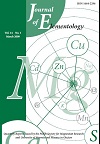Phytotoxicity and speciation of copper and nickel in composted sewage sludge
Issue: 1/2012
Recevied: No data
Accepted: Brak danych
Published: March 22, 2012
Authors:
Jakubus M.
Categories: Pollution and environment
DOI: 10.5601/jelem.2012.17.1.04
Abstract:
In recent years, sewage sludge production in Poland has increased sharply. Composting is one of the most preferable methods for sewage sludge utilization. Compost can improve the physical and chemical properties of soil. However, the quality of sewage sludge composts should be assessed before soil application by using biological and chemical methods. A germination test is used as a biological index to determine the possible phytotoxic effect of composts. Chemical methods are helpful in assessment of availability of metals to plants. This study has been conducted to validate the effect of composting process on phytotoxicty, speciation and availability of copper and nickel in sewage sludge composted with sawdust and wheat straw. The composting process of organic wastes was carried out in chambers of a bioreactor for 28 days; afterwards each chamber was emptied and the content was stored in a closed room for 3 months to allow the maturation process to complete. Samples for analysis were collected at three characteristic phases of the composting process: mesophilic, thermophilic and mature compost. Determinations of the changes in metal speciation as well as metal bioavailability were achieved, respectively, with the technique of BCR sequential analysis and single extraction method using DTPA. Phytotoxicity of the analyzed composts was evaluated with the germination index using cress seeds. It was found that an increasing proportion of sewage sludge in composted mixtures increased copper and nickel content in compost fractions as well as bioavailable quantities of these metals. The germination index increased only during the composting process of a mixture containing 30% of sewage sludge. The compost with 75% share of sewage sludge strongly inhibited germination of cress seeds. The process of compost maturation resulted in an increase of copper in fractions I and III. However, the smallest amounts of copper were determined in exchangeable bonds and the highest ones were determined in bonds with organic matter and sulphides. Composting sewage sludge with sawdust and wheat straw reduced the availability of nickel, which resulted in a decline in the content of this metal in exchangeable bonds (fraction I) but an increase in poorly- and non-extractable ones (fractions III and IV).
Citation:

Jakubus M. 2012. Phytotoxicity and speciation of copper and nickel in composted sewage sludge. J. Elem. 17(1): 43-56, DOI: 10.5601/jelem.2012.17.1.04
Keywords:
sewage sludge, compost, germination index, copper and nickel speciation, bioavailability
About issue:

17.1.2012
Jsite


